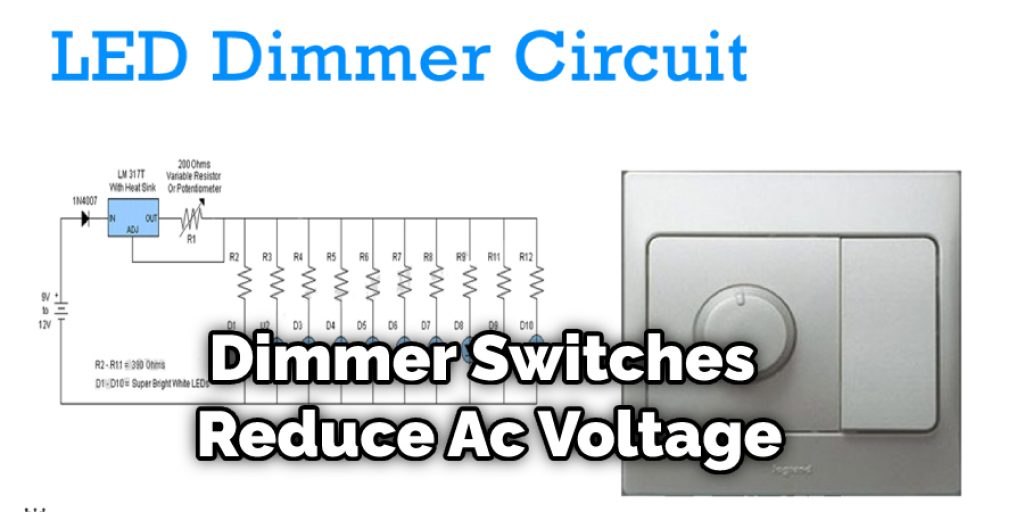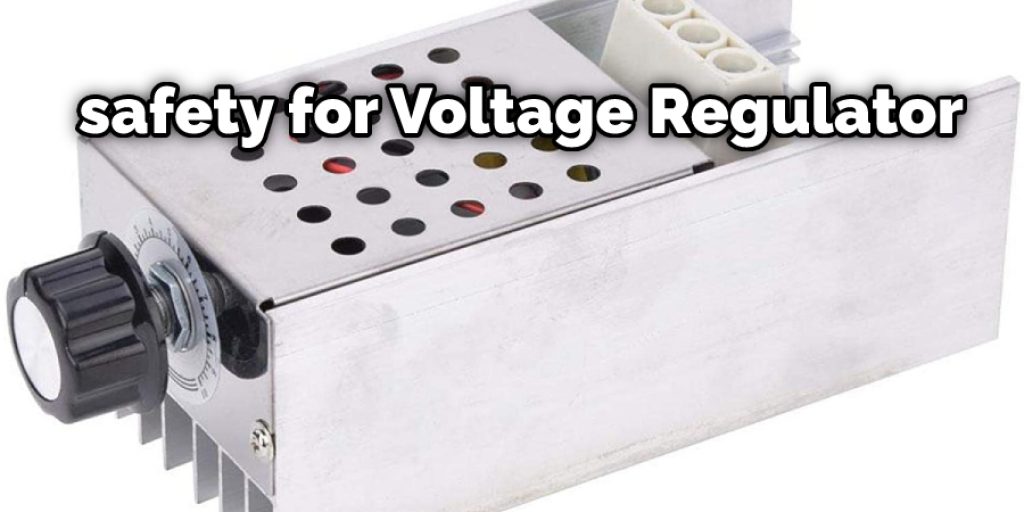How to Reduce Ac Voltage
When it comes to reducing the voltage coming into your home, you have a few options. You can either contact your local electrician and have them install a voltage reducer for you, or you can purchase a voltage reducer and install it yourself. In this blog post, we will provide you with instructions on how to reduce ac voltage using different methods.

Keep in mind that while reducing the voltage is an effective way to save money on your energy bill, it will also reduce the overall power of your appliances. So if you’re looking to save money without sacrificing too much power, reducing the AC voltage is a great solution for you! So read this blog post to know how to do so.
What is AC voltage?
Before we dive into the methods of reducing AC voltage, let’s first understand what it is. AC (alternating current) voltage is the electrical energy that flows through your home’s power outlets to power your appliances and devices. It is measured in volts (V) and can vary depending on your location and electrical grid.
You may be wondering why you would want to reduce the voltage coming into your home. The answer is simple – higher voltage means higher energy consumption and a higher electricity bill. By reducing the voltage, you can save money on your energy bill without compromising on the functionality of your appliances.
Why reduce AC voltage?
Reducing AC voltage can have several benefits, such as saving energy and reducing your electricity bill. It also helps to prolong the lifespan of your appliances by preventing them from working at higher voltages than they require. Additionally, it can help to improve the efficiency of your electrical system and reduce the risk of electrical fires.
The standard voltage in most homes is 120V, but this can vary depending on your location. By reducing the voltage to a lower level, such as 110V or even 100V, you can save money without sacrificing too much power.
It’s important to note that reducing the voltage should only be done in a controlled and safe manner. Make sure to follow all instructions carefully and consult with a professional if you are unsure.
Necessary Materials:
Voltage Reducer (Purchased or Provided by Electrician):
- If you are purchasing a voltage reducer, make sure to consult with a professional electrician to ensure you get the right one for your home’s electrical setup.
- If you are having an electrician install a voltage reducer for you, they will provide the necessary materials for the installation process.
Safety Equipment:
Safety Glasses:
- Safety glasses are necessary to protect your eyes from any debris or sparks that may occur during the installation process.
Gloves:
- It is recommended to wear gloves, preferably rubber or insulated ones, to protect yourself from any potential electrical shocks.
10 Effective Methods How to Reduce Ac Voltage:
1. Use a Ground Fault Circuit Interrupter (GFCI)
A GFCI responds to electric imbalances or differences in currents between electrical paths. These devices, therefore, offer protection from electrical shock and concomitant injury, especially when the device detects a difference in current between the hot wire and another conductor such as a person or appliance.

2. Use a Surge Protector
A surge protector is an appliance or device designed to protect electrical devices from voltage spikes. Different types of protection mechanisms are used in surge protectors, and these mechanisms can be electronically separated into two groups: Those that respond quickly and those that respond slowly. Electronic circuits use metal-oxide varistors (MOVs) as the fast response component, while chemical varistors (or MOVs) work as a slower response component for large surges.
You can plug a surge protector into an outlet and then connect your electrical devices to the surge protector. When a voltage spike occurs, the device diverts excessive voltage through the grounding wire of the building, thus protecting any connected devices from being damaged.
3. Use a Resettable Circuit Breaker
Circuit breakers are designed to protect electrical wiring and appliances by detecting when the current exceeds safe limits or is otherwise abnormal and then cutting power to the circuit to extinguish the current. The same mechanism is used for both overload and short circuits.
You can use a resettable circuit breaker to help reduce AC voltage by setting the maximum voltage limit you want it to allow through. If the voltage exceeds this limit, the circuit will trip and stop any current from passing through.
4. Use a Transformer
A transformer is an electrical device that transfers electrical energy from one circuit to another through inductively coupled conductors to the transformer’s coils. A varying current in the first or primary winding creates a varying magnetic field in the transformer’s core and thus, a varying magnetic flux in the secondary winding. This varying flux induces a voltage in the secondary winding, which is called an “induced e.m.f.”
The transformer can step down the voltage coming into your home from a higher level to a lower level. This can effectively reduce AC voltage and save you money on your energy bill.
5. Use a Voltage Regulator
A voltage regulator or stabilizer maintains constant voltage levels despite changing AC input (line) voltage. A simple voltage regulator employs a series of metal–oxide varistors (MOV) in the output line; these devices conduct excess current to the ground. This simple regulator is effective but wastes power, as it shunts some current even if there is no regulation required.
It’s recommended to consult with a professional electrician when considering using a voltage regulator to make sure it is appropriate for your home’s electrical setup.
6. Avoid Plugging Too Many Appliances into a Power Strip
Many people use power strips to plug multiple appliances into one outlet, but this will draw more current from the wall and ultimately lead to the higher voltage. Instead, consider purchasing a step-down converter to use multiple appliances.
You can also reduce the voltage by not plugging in appliances that do not need to be on at all times, such as phone chargers or small kitchen appliances.
7. Use a Step-Down Transformer
A step-down transformer is a type of transformer used to “step down” (reduce) the voltage supplied by a source instead of stepping up the voltage as an electrical generator does. A step-down transformer is also often used with a center tap on the secondary coil.
It’s important to consult with a professional electrician when considering using a step-down transformer to ensure it is appropriate for your home’s electrical setup.
8. Use a Voltage Converter
A voltage converter is an electronic circuit or electromechanical device that converts electric power from one voltage to another, usually higher or lower, in alternating current circuits or electric power systems. An example would be the type of transformer used in combination with a step-down transformer to produce specific voltage for things such as a dryer.
You should consult with a professional electrician when considering purchasing and using a voltage converter to ensure it is appropriate and safe for your home’s electrical setup.
9. Switch to a Lower Voltage Light Bulb
You can use a lower-wattage light bulb instead of a higher one, but keep in mind that you will be wasting energy if the power is reduced from 110 v or 220 v to 100 v or below. The advantage of this method is that it will help reduce the voltage since lower-wattage light bulbs put out less energy.
It’s recommended to consult with a professional electrician when considering switching to lower voltage light bulbs to ensure they are safe for your home’s electrical setup and do not cause any issues.
10. Dimmer Switches Might Help Reduce Ac Voltage
Dimmer switches can be used to reduce AC voltage, but keep in mind that it doesn’t necessarily mean that you are reducing the power to that device or appliance; it simply means that you are changing how much of that power is being used. If your goal is to reduce the energy being supplied, it will not help if you use a dimmer switch to reduce how much energy you are using, but it may hurt more since dimming controllers use less voltage when turned down completely.

Following these methods can help reduce AC voltage in your home, which can ultimately save you money on your energy bill and protect your appliances from potential damage. It’s important to consult with a professional electrician before implementing any change to your electrical setup to ensure it is done safely and properly.
Some Helpful Tips and Suggestions:
Here are some tips and suggestions on how to reduce AC voltage.
1. If you can avoid it, do not touch electrical equipment when your hands are wet.
2. Keep all electronic equipment away from water, and make sure there is a drip pan underneath before using it in an area where spills may occur.
3. If possible, use three-pronged plugs on all of your electrical devices to avoid the chance of being shocked by them.
4. Do not use surge protectors with faulty outlets or power strips with metal pins that have been worn down.
5. The best option for keeping the voltage at a safe level is to call an electrician to install a sub-panel in your home, safely reducing the voltage to 110 volts.
6. Be sure to always keep a safe distance between electrical cords and other items that could cause you to trip over them, such as pets or children.
7. If your house has aluminum wiring, have it replaced immediately by a certified electrician to prevent dangerous shocks from the high-voltage wires.
What Is The Difference Between Lower Plants And Higher?
The voltage between two points on a circuit is the potential difference. Voltage can be caused by various factors, such as an insect touching a hot wire in a transformer. In this case, the voltage causes electrons to flow through the bug from one point to another. The same amount of current will flow no matter how many times you halve the voltage.
A voltage source is referred to as a potential difference and can be either a direct current (DC) or alternating current (AC). Direct current flows in only one direction, while alternating current changes direction at regular intervals. A voltage drop decreases the potential difference between two points on a circuit. It can be caused by resistance in the wire, semiconductors, or other components within the circuit. Voltage drops are often undesirable, but they can be useful when reducing AC voltage.
How To Lower The Amperage?

There are a few things that can be done to reduce the amperage of your AC system. The best and quickest way is to change the value of your capacitors. A capacitor, besides storing voltage, also stores currently. When voltage is applied to the capacitor plates, they begin storing up current as a battery would. The more volts per plate you have, the more current can be stored.
If your capacitors are rated at 450v, you will only be able to store 450v of AC on them (lead to lead). But, if you were to raise your voltage rating higher, say 1800v per plate, then the amount of amperage they will allow you to store will increase substantially. To make this adjustment, you will have to raise the value of your variable. For example, a 500v cap start rated at 1800v per plate can be used, and the AC dropout becomes three times lower than it was with a 450v capacitor! It doesn’t matter how much voltage you feed the capacitor, and it only holds current.
Safety Precautions and Warnings:
1. Be sure your circuit is sealed with electrical tape.
2. Make sure all loose connections are tight and you’ve soldered them together.
3. Do not touch any exposed solder or wire on the bottom of the board; it is capacitively coupled with the induction coil, which can shock you if your finger is wet or dirty enough.
4. Electrodes smaller than 1/2″ have been known to cause skin blistering, so be careful.
5. Make sure your electrodes are not too close together to avoid arcs or shocks and prevent burns from the electrodes themselves getting too hot!
6. Make sure the electrodes are not too far apart, or else you won’t be able to get a decent arc; this will cause problems heating the air around it. The focusing electrode also should not touch any metal on the board.
7. The electrode’s sharp points can puncture through things like vinyl sheets, gloves, clothing, skin, etc., so keep away from them!

Frequently Asked Questions:
Q: Can I Reduce AC voltage by Using a Transformer?
A: Yes, a transformer can step down the voltage from the source to the desired level. However, it’s important not to overload the transformer, as it can overheat and potentially cause a fire hazard. It’s best to consult with an electrician before using a transformer. You may also need to use a voltage regulator in conjunction with the transformer for more precise control of the voltage. It’s always best to consult with a professional to ensure the safety and proper usage of any electrical equipment or devices.
Q: How Can I Tell If My Home Has High AC Voltage?
A: There are a few signs that may indicate high AC voltage in your home, including flickering lights, electronics or appliances malfunctioning or burning out frequently, buzzing sounds coming from outlets, and shocks or tingling sensations when touching electrical equipment. It’s important to have an electrician inspect your home if you experience any of these signs.
Q: Can Reducing AC Voltage Save Energy?
A: Yes, by reducing the voltage in your home, you can potentially save energy and reduce your energy bill. This is because lower voltage means less power being used by your electrical devices and appliances. However, it’s important to note that reducing the voltage too much can also cause problems with the functionality of your electronics and appliances. It’s best to consult with an electrician before making any changes to your home’s voltage.
Q: What Can Happen if My Home Has High AC Voltage?
A: If your home has high AC voltage, it can lead to several safety hazards, such as electric shock, fires, and damage to electrical devices. High voltage can also cause inefficient energy usage and increase your electricity bill. It’s crucial to address high AC voltage in your home as soon as possible by consulting with an electrician.
Q: How Often Should I Have My Home’s Electrical System Checked?
A: It is recommended to have your home’s electrical system checked every 3-5 years by a certified electrician. This will ensure that your electrical system is functioning properly and safely, and any potential issues can be addressed before they become major problems. It’s also important to have an inspection done if you notice any signs of high voltage or other electrical issues in your home.
Conclusion:
In conclusion, there are several ways to reduce ac voltage. The most effective way to reduce the voltage is by using a transformer. Transformers can be used in both commercial and residential settings. If you are looking for an easy way to reduce the voltage in your home or office, a transformer is the best option.
Using the methods we’ve outlined in this article on how to reduce ac voltage, you can help ensure that your equipment is protected from potentially harmful voltages. Have you tried any of these techniques? Let us know in the comments below!
You can also check it out to Run Low Voltage Wire Under Sidewalk




